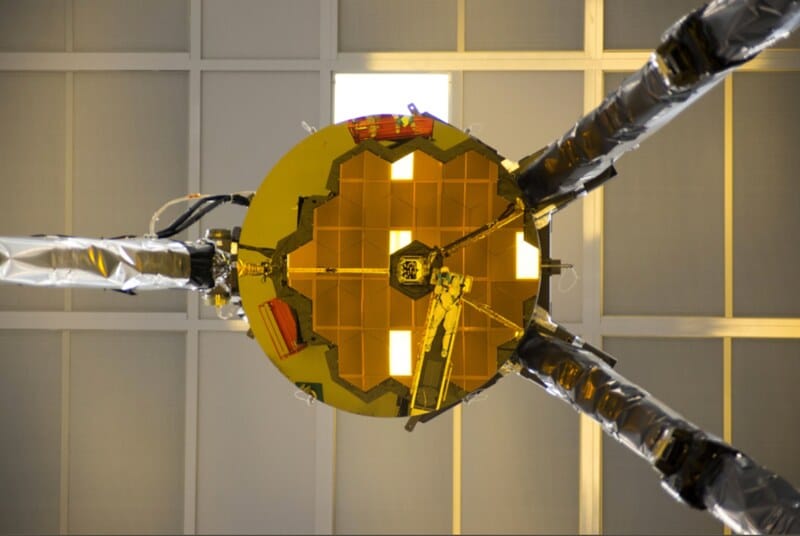

Once again an important milestone has been reached.
The Webb team comes with great news. Because the mighty James Webb telescope has successfully positioned the second mirror. “It’s another memorable day,” said Webb project manager Bill Ochs, congratulating the team.
second mirror
The second or secondary mirror is mounted on a tripod consisting of three lightweight, fold-out supports, each over seven meters long. When light from the distant universe hits the iconic 18 gold mirrors (which make up the primary mirror), it will bounce off the smaller, round, secondary mirror. Then the second mirror reflects the light collected by the main mirror into James Webb’s onboard scientific instruments.

The second transom, supported by three lightweight rods. The main mirror can be seen in the reflection. Image: NASA
Yesterday afternoon it was time for the exciting implementation of the secondary mirror. The tripod, on which the secondary mirror rests, was moved and installed in its operational position. In effect, James Webb ‘swung’ his ‘arm’ forward to get the secondary mirror right in front of the primary mirror.
That’s how it went
Implementing the mirror was a nerve-wracking part. The secondary mirror is one of the most important parts on the telescope and essential to the success of the mission. The process started at ten to four Dutch time. And about an hour and a half later the mirror was in position. The tripod was then locked twenty minutes later. Just before half past six Dutch time, the word came out: engineers confirmed that the tripod was fully secured and locked in place. In short: the implementation of the secondary mirror was completed. “The world’s most advanced tripod has been commissioned,” said Lee Feinberg of NASA, who is responsible for the mirrors.
Finally a real telescope
James Webb, meanwhile, is starting to look more and more like a telescope. The telescope was origami folded during launch to fit inside an Ariane-5 rocket. And now, as the telescope flies through the vast universe, it successfully unfolds more and more parts. “It’s really unbelievable,” says Ochs. “We are currently more than 965,000 kilometers from Earth. And we finally have a real telescope.”
Radiator
James Webb may be increasingly taking on the shape of a telescope, but we’re not quite there yet. Because there are still some important parts to be prepared. The next element is the radiator (ADIR), which is located at the rear of the telescope. The job of this radiator is to conduct heat away from the instruments and mirrors. Among other things, the telescope must be kept cold in this way, otherwise Webb will not be able to observe the infrared light from faint, distant objects.
In order to detect those weak signals, the telescope itself must therefore be extremely cold. That is why a 5-layer sun shield, the size of a tennis court, has been manufactured. This shield will protect the telescope from external light and heat sources (such as the sun, earth and moon) and from the heat radiated by the observatory itself. You can therefore compare this sun shield a bit with a parasol, which will always be directed towards the sun to repel heat and light. This immense solar shield was already unfolded and successfully tightened a few days ago.
Source material:
“Secondary Mirror Deployment Confirmed” – NASA
Image at the top of this article: Adriana Manrique Gutierrez, NASA Animator